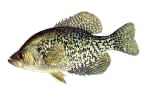|
|
|
Whether you want to spend a
relaxing
evening
fishing, or
are a
professional
looking to
catch "the big
one", Lake Murray has the fish for you!
|

|
Black
Crappie
Like
other members of
the sunfish
family, Black
Crappie are nest
builders. They
nest in the
spring,
generally when
water
temperatures
reach
60°F.
Black Crappie
adults main diet
is insects and
crustaceans. |

|
Bluegill
(also
called Bream,
Sunfish)
Bluegills
begin spawning
when water
temperatures
reach about
70°F.
Nests are
created in
shallow water,
one to two feet
in depth. Gravel
substrate is
preferred. Fifty
or more nests
may be crowded
into a small
area, thus
creating a
spawning bed.
Males guard the
nest until the
eggs hatch and
fry leave. Young
fish feed on
plankton, but as
they grow the
diet shifts to
aquatic insects
and their
larvae. |

|
Redbreast
Sunfish (also
called
Redbreasted
Bream, Shell
Cracker,
Yellowbelly
Sunfish)
In
typical sunfish
fashion, the
redbreast spawns
as the
temperature
nears 70 in beds
or colonies on
sand or gravel
where the water
is one to three
feet deep.
Spawning
activities also
cycle around the
full moon
periods.
After hatching,
the young may
remain schooled
for several
weeks before
scattering.
Adults feed on
insects, snails,
crayfish, and
small fish. |

|
Redear
Sunfish (also
called
Redear Bream,
Shell
Cracker)
The
"red ear"
distinguishes
this sunfish
from the others.
Like the
Redbreast, their
food preference
is snails -
which has earned
them the
nickname "Shell
Cracker",
although they
also feed on
insects, insect
larvae and
worms.
Spawning
activities are
similar to the
other Bream
varieties. |

|
Catfish
Catfish
spawn in late
spring or early
summer when
water
temperatures
reach 75°F.
Males select
nest sites which
are normally
dark secluded
areas such as
cavities in
drift piles,
logs, undercut
banks, rocks,
cans, etc.
Catfish less
than 4 inches in
length feed
primarily on
small insects.
Adults are
largely
omnivorous,
feeding on
insects,
mollusks,
crustaceans,
fish, and even
some plant
material.
|

|
Large
Mouth Bass
Spawning
begins in the
spring when
water
temperatures
reach about
60°F.
Largemouth bass
prefer to nest
in quiet, more
vegetated water,
but will use any
substrate
besides soft
mud, including
submerged logs.
Nests are
usually built in
two to eight
feet of water.
Fry feed
primarily on
insect larvae.
At about two
inches in length
they become
active
predators.
Adults feed
almost
exclusively on
other fish and
large
invertebrates
such as
crayfish.
|

|
Striped
Bass (also
called
Stripers,
Rockfish)
South
Carolina's
"State Game
Fish", the
striped bass is
the largest
member of the
sea bass family.
Lake Murray's
population
completes their
entire life
cycle in
freshwater.
Stripers may
reach a size of
10 to 12 inches
during the first
year. Males are
generally mature
in two years,
and females in
three to four.
Adults are
primarily
piscivorous,
feeding
predominantly on
members of the
herring family
such as gizzard
shad and
threadfin
shad.
Average adult
size is 20-36
inches and 3-10
lbs.
|

|
White
Perch
Like
the Striped
Bass, White
Perch are native
to the Atlantic
Ocean, but have
adapted well to
freshwater (the
building of dams
kept early
generations from
returning to the
ocean after
spawning). They
release their
adhesive eggs
randomly into
shallow water.
Adults feed near
the bottom upon
aquatic insects,
invertebrates, a
wide variety of
fishes, and on
the eggs of
other fish
species.
Average adult
size is 7-12
inches and up to
1 lb. |
|
|



